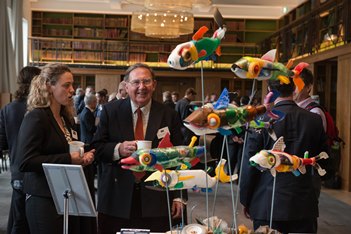 A multi-coloured work of art made entirely from litter is highlighting the shocking levels of dumped plastic in London’s river.
A multi-coloured work of art made entirely from litter is highlighting the shocking levels of dumped plastic in London’s river.
Michelle Reader’s A Bellyful of Plastic was made using rubbish collected on the River Thames. It was created after experts revealed that stunning numbers of fish living there have plastic in their gut.
The work is part of the Cleaner Thames Campaign, launched by the Port of London Authority (PLA), Thames 21, Tideway and Totally Thames launched last year following research done by experts at Royal Holloway, University of London. It showed that three quarters of Thames flounder, a bottom-feeding fish, had consumed plastic. More than a fifth of smelt that were studied also consumed plastic.
Michelle used litter collected by the PLA on the 95-mile stretch of the tidal Thames that it looks after and a Thames 21 foreshore clean up in Grays. The sculpture, which shows a shoal of smelt, includes containers, bottles, shoes and even hats.
Artist Michelle Reader said: “It was both fascinating and a little disturbing to see the variety of material that collects in the water and on the foreshore. I was surprised by the sheer number of balls, discarded cotton buds and other items.
“It was an interesting challenge to turn it into something visually appealing, something that would tell a story in a way that could capture people’s imagination. I wanted to make people think about what happens to their waste, by drawing them in to take a closer look.”
 PLA environment manager Tanya Ferry revealed that the authority collects 300 tonnes of litter and driftwood from the Thames every year, much of which is made up of plastic materials like single use plastic bottles.
PLA environment manager Tanya Ferry revealed that the authority collects 300 tonnes of litter and driftwood from the Thames every year, much of which is made up of plastic materials like single use plastic bottles.
“That’s the equivalent weight of twenty-four thousand discarded water bottles and it is probably only a small share of the total amount being dumped which damages our marine environment,” she said. “A Bellyful of plastic is a colourful reminder of what’s being done to our marine environment. The amount of waste being dumped in the Thames is simply hard to stomach and that’s why we’re working hard to clean it up.”
Debbie Leach, Chief Executive at Thames21, a waterways charity putting healthy rivers back at the heart of community life, said:
“Plastic pollution is a very real problem in our rivers today. Because plastic doesn’t biodegrade, it is often ingested by wildlife mistaking it as food. The litter Michelle has recycled into this colourful artwork could not better demonstrate the scale to which this is an issue. Her thought-provoking piece also reminds us how we all have a hand in reducing plastic polluting our rivers.”
 The Thames is home to 125 different fish species, 300,000 wintering birds, over 900 seals and nine sites of special scientific interest.
The Thames is home to 125 different fish species, 300,000 wintering birds, over 900 seals and nine sites of special scientific interest.
The Cleaner Thames campaign wants to stop the tide rubbish that is ending up in the Thames and is calling on people to make sure their rubbish goes in the bin, not the world-famous River Thames.
A Bellyful of Plastic will be visiting campaign supporters and other sites along the Thames, to raise awareness of the litter problem and encourage people to dispose of rubbish more carefully.
Source: PLA